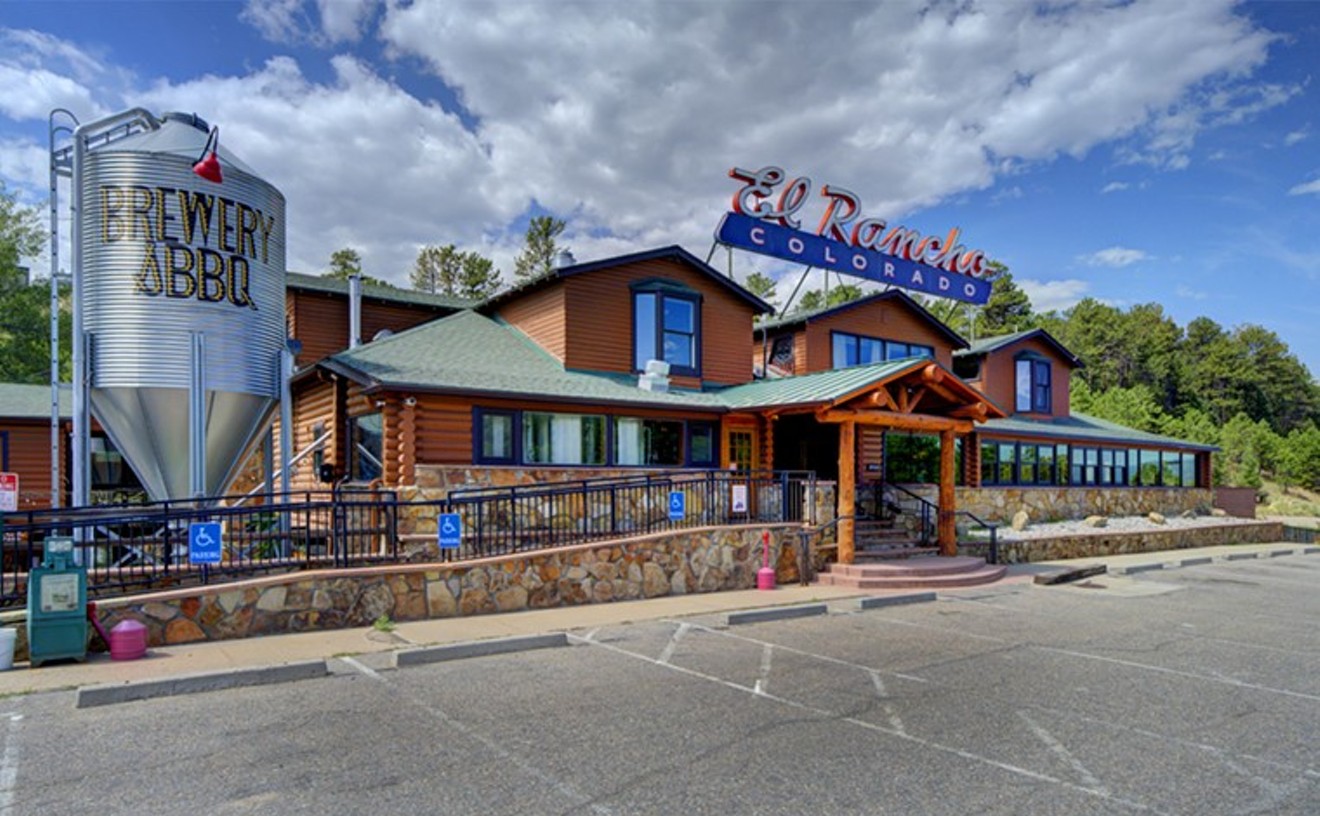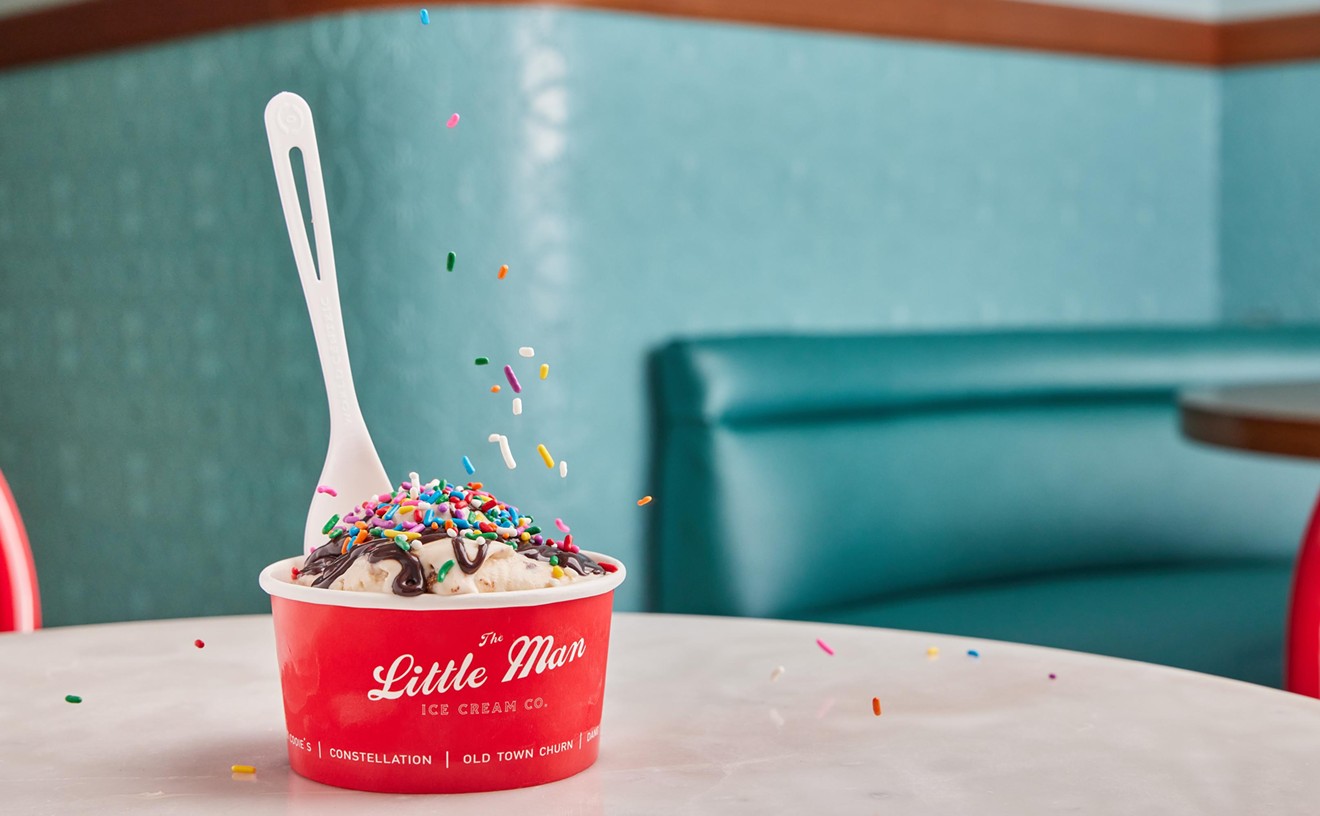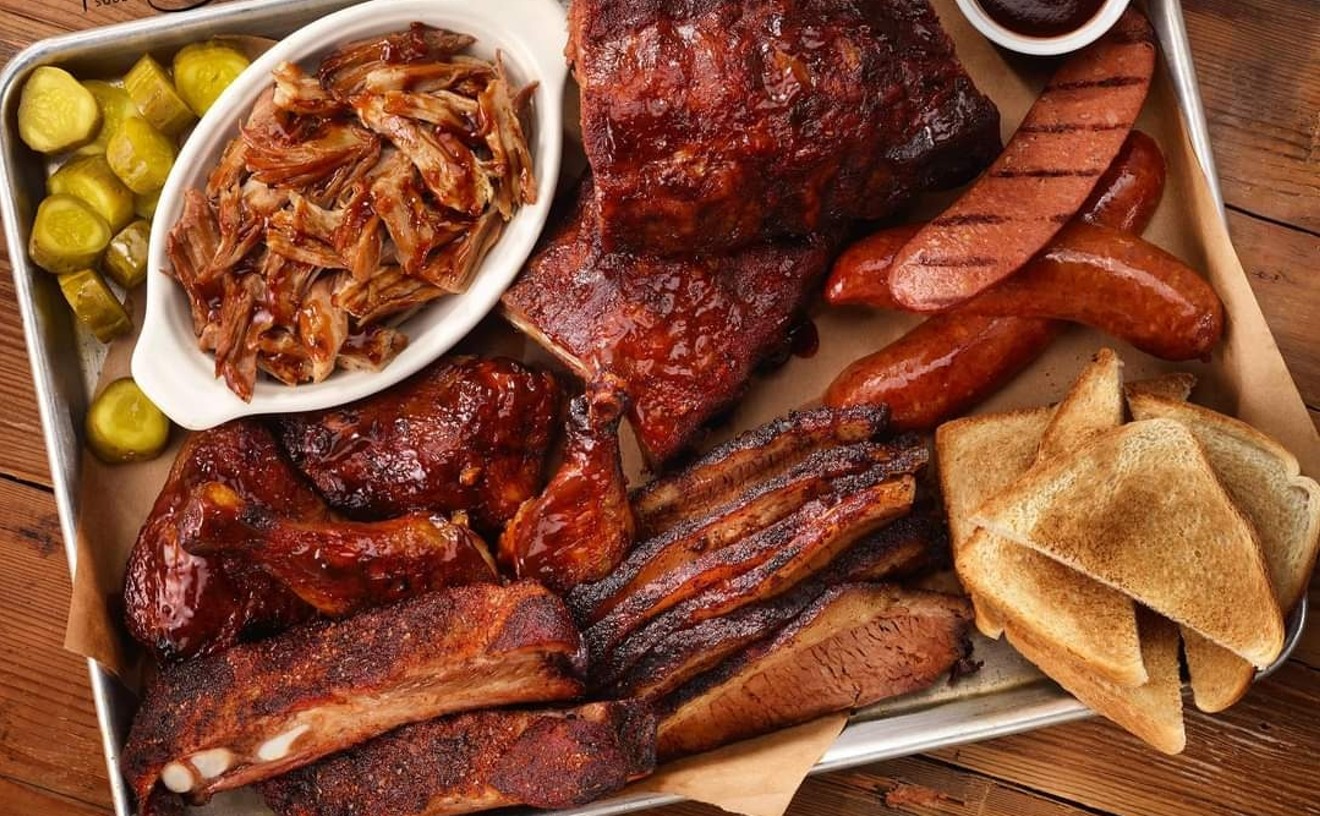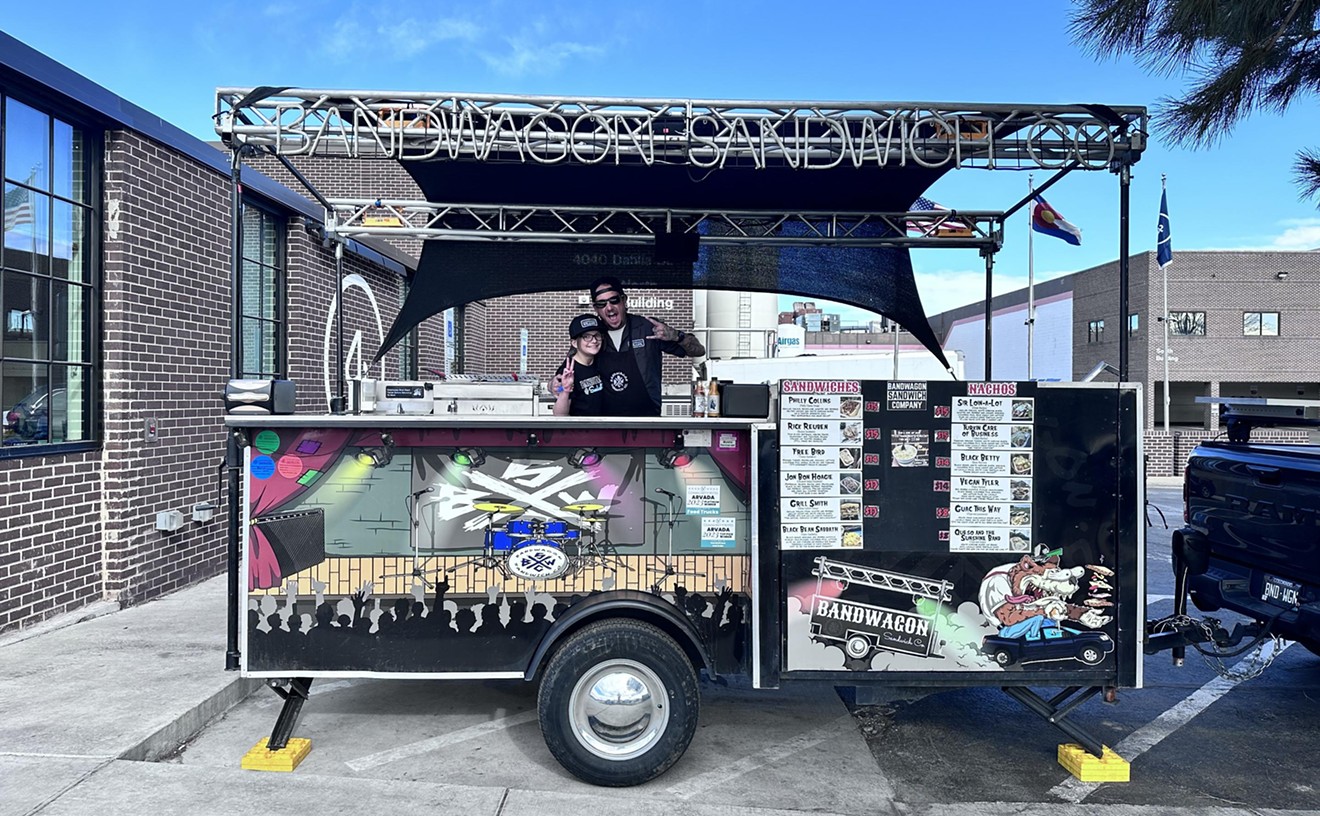"We'll have head cheese at Olivéa on Friday — I expect to see you there," summoned the e-mail. The note, short and to the point, was from John Broening, the executive chef at Duo and Olivéa — the former a restaurant in Highland with a field-to-plate, seasonal approach to food, the latter a three-month-old restaurant in Uptown that embraces the same elemental philosophies but pushes the culinary envelope by serving, among other things, head cheese, a gelatinous loaf comprised of the brains, tongue and head parts of a pig. There are very few Denver chefs pimping head cheese, and that, right there, is why Broening is not your pig-in-a-blanket chef.
Growing up, he lived in France, the Soviet Union and, eventually, Portugal, where his father was a foreign correspondent for the Associated Press. (Broening is a writer, too, occasionally penning food stories for the Denver Post.) But his cooking career didn't launch until 1988, when he went to culinary school in New York, a move that was followed by numerous kitchen spells in the Big Apple, San Francisco and Paris, where Broening was a poissonier under Guy Savoy at Bistrot de l'Etoile Niel.
He moved to Colorado in the late '90s to command the kitchen at Primitivo in Colorado Springs, and then in 2003 was lured to Denver to run the line at Brasserie Rouge, now the Icehouse Tavern. He then did time at Udi's on Broadway, where he met his wife, Yasmin Lozada-Hissom, the pastry chef at Duo and Olivéa.
Broening is an erudite chef who keeps to himself, preferring the lights in his kitchen to the limelight of the front page, but he's also remarkably candid, sticking it — hard — to steakhouses, taking umbrage at Top Chef judge Tom Colicchio and admitting that he'd like to bump Emeril Lagasse all the way to BAM! and back.
Six words to describe your food: Clean, traditional, not stuffy, fresh, seasoned, deceptively simple. That's eight words, but who's counting?
Ten words to describe you:
Uh, introverted, cerebral.... I don't know — you'd have to ask somebody who knows me.
Culinary inspirations: My wife and my mother. Besides being Denver's best pastry chef, Yasmin, my wife, who's also the pastry chef at Duo and Olivéa, is a great home cook. She lived in Italy for four years, so she makes Italian food the way Italians make it: simple, flavorful pastas and the best super-refined risotto I've ever had. Actually, she makes a porcini risotto that starts with a pinch of saffron, and then she finishes it by folding in a little whipped cream. Wow! And since she's half-Peruvian and half-Venezuelan, she can cook the food of both countries. I love her arepas filled with butter and white cheese or with braised skirt steak, plantains and sweet black beans. Right now, my favorite dish in her repertoire is her tuna saltado — tuna braised with soffritto, stir-fried with potatoes, vinegar and soy sauce and served over rice. It's a dish that shows the happy influence of the ethnic Chinese on Peruvian cooking, and it's making me hungry just thinking about it. Escoffier preferred his wife's cooking to his own, and I feel the same way. When I first met my wife, I was a French chef who finished everything with butter, tortured vegetables into small, even shapes and specialized in long reduction sauces. Among other things, Yasmin showed me the importance of acidity in food.
I never touched a pot growing up, but I did love my mother's cooking. She learned to cook when we lived in France in the '60s. She'd take ingredients that she'd find in the market and, with the help of Craig Claiborne and Julia Child, interpreters of French food for several generations of Americans, put together a repertoire of dishes that are still my touchstones for what a good vichyssoise, roast chicken, boeuf bourguignon or apple tart should be.
Proudest moment as a chef: In order to make a living, I cook to please the general public, but in my heart, I cook for my peers. Any time I can cook something that makes another chef happy and excited, I'm proud. And any time one of my former cooks or sous chefs makes their mark in the world, it fills me with pride, especially if we've had a contentious work relationship, which is more often the case than not.
Favorite ingredient: Fennel seed or anything anise-flavored, including fennel, anise seed, sambuca, tarragon and Thai basil.
Best food city in America: New York (though Chicago is a close second), simply because of technique, ingredients and innovation. New York also has the best dining audience — not just great, sophisticated and adventurous diners, but also the best food writers and critics in the country.
Favorite music to cook by: Glenn Gould playing Bach. I also like Sidney Bechet and Steely Dan.
Most overrated ingredient: Ingredients for a cook, like specimens for a scientist, are either good or bad quality. They aren't overrated as much as they're over-used or misused. Cream is over-used by most chefs, and so are bell peppers and balsamic vinegar, especially in sticky-sweet balsamic vinegar reductions.
Most undervalued ingredient: The bay leaf is the Shane Battier of ingredients; it makes every other ingredient perform better, and used properly, it gives an invisible depth of flavor to everything.
Rules of conduct in your kitchen: Show up on time, focus, work clean, be respectful of the food and each other, and no gum-chewing or whistling. And if you have suggestions about how to improve something in the kitchen — a system, a recipe — let me know.
Favorite New York restaurant: Casa Mono. Although it's a tiny, uncomfortable restaurant with perfunctory service, dish for dish, it's the best restaurant in America.
One food you detest: Any chain restaurant hamburger or pizza. Domino's is particularly disgusting. Their pizzas are dense, undercooked and buckled with cheap cheese and tomato sauce.
One food you can't live without: I have a wicked sweet tooth, so anything with chocolate and caramel makes me happy, especially a Cadbury Caramello.
Most embarrassing moment in the kitchen: Many years ago, when I was a beginning line cook, I worked in a restaurant where all cooks were encouraged to contribute to the menu. For lunch service, I came up with a prosciutto sandwich special, which I didn't bother to taste before assembling. Halfway through lunch service, the owner, whose name was also the name of the restaurant, came up to the window and told the chef, who was working next to me, that the customers were complaining that the sandwich was dry and tasteless and that he was going to 86 it right away. The chef hung his head and said, "Okay, boss." After the owner walked away, the chef picked up a couple of plates and, without even looking, started winging them in my direction. I learned two valuable lessons that day: Always taste your food, and never make your boss look bad.
What you'd like to see more of in Denver from a culinary standpoint: Denver, like the rest of Colorado, has a marvelous beer culture with talented brewers who are as passionate, sophisticated and creative about what they do as any chef or winemaker. So why is it that the food in microbrewery restaurants is so bad? It's unimaginative, made with cheap ingredients and cooked without any love or technique. San Francisco, Chicago and the Pacific Northwest have beer cultures equal to ours, but they also have restaurants where the quality of the food is up to the quality of the beer.
What you'd like to see less of in Denver from a culinary standpoint: Where do I begin? I hate seeing TVs in restaurants, and I loathe sports-themed restaurants and chain restaurants. I've said this before, but nothing saddens me more than the enormous success of steakhouses in Denver. They take a huge chunk out of the fine-dining top dollar, they're reactionary and they stand against everything good — seasonal ingredients, using lesser-known cuts of meat, making everything in-house and in manageable portions — that's emerged in the food world in the last thirty years. And to add insult to injury, steakhouses don't really teach their cooks anything besides cooking steaks to temp and being able to handle volume.
Denver has the best: Pho! I love Pho 95, New Saigon and Pho 79. I've also heard great things about Pho Duy, which I haven't tried yet.
Denver has the worst: Remember everything I said about chain restaurants, steakhouses and the food at microbreweries?
Favorite cookbook: The River Cottage Meat Book, by Hugh Fearnley-Whittingstall. Most cookbooks cut to the chase with a brief intro followed by a few easy recipes. The recipes in this cookbook don't even start until a couple hundred pages in, so it allows Fearnley-Whittingstall to give us everything about meat — the philosophy, history, science and technique — before he jumps into the recipes. And rather than being truculent about his love of meat, he genuinely tries to understand the vegetarian point of view.
What show would you pitch to the Food Network? Let's Hunt, Kill and Cook Emeril Lagasse. Of course, it would have to be a special rather than a series.
Weirdest thing you've ever eaten: Deep-fried pregnant anchovies with my foodie friend Robert Pincus, who has a predilection for the offbeat in food. In fact, he once brought me a bottle of Korean moonshine that he acquired in Pusan, which had this indescribably funky swampwater taste that I'll never forget.
Current Denver culinary genius: Genius is as rare in the culinary world as it is anywhere else and can be dangerous when applied to something as homely as cooking, but there are a handful of Denver chefs I respect: Patrick Dupays, of course, for his dedication to his very personal vision of what good food should be; Alex Seidel, for his rock-solid technique; Jen Jasinski, who is the complete package — cook, leader and manager and businesswoman; Sean Kelly, the éminence grise of Denver chefs; and all the anonymous wok-slingers who make this such a great town for Vietnamese food.
You're making a pizza. What's on it? At Olivéa, my favorite pizza has prosciutto, green-olive tapenade and shaved pecorino nero.
You're making an omelet. What's in it? I hate omelets.
After-work hangout: Home with my wife and our three dogs. I'm almost 46, and my days of carousing after work are long over.
Favorite Denver restaurant other than your own: Z Cuisine. Eating there is like being a guest at a wonderful dinner party.
Favorite celebrity chef: Mario Batali. He cooks like a wizard, he's funny and outrageous, and he has a vision — not just of Italian food, which he's changed more than any other chef in America — but of leadership: He hires strong, talented chefs and makes them partners.
Celebrity chef who should shut up: Tom Colicchio. You can't call yourself Mr. Farm-to-Table once you've made a Diet Coke commercial and shepherded a bunch of cheftestants through a Top Chef challenge using Pringles potato chips.
Hardest lesson you've learned: That in a restaurant, service matters as much as food. Duo is as much of a success because of the warm, competent and unpretentious service as it is for the food. As chefs, we assume that a restaurant begins and ends with the food, but of course that's a long way from the truth.
What's next for you? I'd love to find a publisher for my cookbook.
Every week in Chef and Tell, Lori Midson features a Denver chef. Read the full interview on the Cafe Society blog. Contact her at [email protected].










